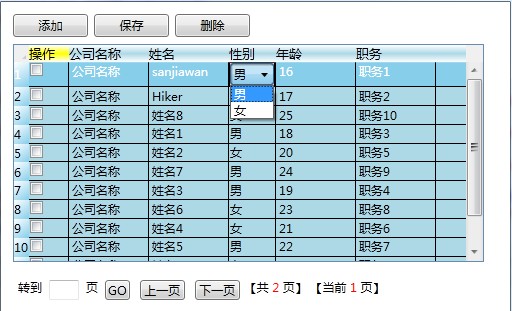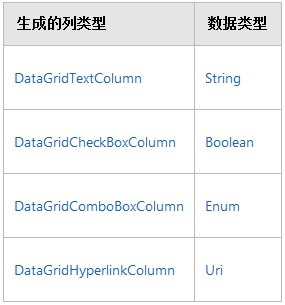标签:style blog http io color os ar 使用 for
前几天打算尝试下DataGrid的用法,起初以为应该很简单,可后来被各种使用方法和功能实现所折磨。网络上的解决方法太多,但也太杂。没法子,我只好硬着头皮阅览各种文献资料,然后不断的去尝试,总算小有成果。因此,把我学到的和大家分享一下,相信这篇文章会让你再很短的时间内学会DataGrid的大部分主要功能,而且很多难点都可以在里面找到解决方案。
由于涉及的应用比较多,所以篇幅会很长。但可以确保各个版块相互独立,总共4个部分
1.数据绑定
2.DataGrid的增改删功能
3.DataGrid的分页实现
4.DataGrid的样式设计
先上一张截图,让你大概知道自己需要的功能是否在这张图里有所实现。

PS:使用技术:WPF + ADO.NET Entity Framework
1.数据绑定(涉及DataGrid绑定和Combox绑定)
在DataGrid 中同时包含“自动生成列”与“用户自定义列” 由属性AutoGenerateColumns控制。
默认情况下, DataGrid 将根据数据源自动生成列。 下图列出了生成的列类型。

如果AutoGenerateColumns="True" ,我们只需要如下几行代码
<DataGrid Name="dataGrid1" AutoGenerateColumns="True" />
后台dataGrid1.ItemsSource = infoList; //infoList为内容集合(这是我从数据库中获取的记录集合 类型为List<T>)
PS:因为这里给dataGrid1绑定了数据源,所以下面绑定的字段都是infoList中的字段名称,同样也对应着我数据表中的字段名。里面包含FID,公司名称,职员姓名,性别,年龄,职务。解释下,怕大家无法理解Binding 后面的值是如何来的了
显然这种数据绑定非常的容易,如果对表格要求不高,这中无疑是最简单方便的。
如果AutoGenerateColumns="False" 表格字段的显示就要靠我们手动去完成了。这个也是数据绑定的重点,因为实际应用中我们大多都是自定义去完成DataGrid的数据绑定。
接下来贴出代码(后面的所有功能都可以在此代码基础上添加和修改)
- <Window x:Class="CSDN_C.MainWindow"
- xmlns="http://schemas.microsoft.com/winfx/2006/xaml/presentation"
- xmlns:x="http://schemas.microsoft.com/winfx/2006/xaml"
- xmlns:assembly="clr-namespace:System;assembly=mscorlib"
- xmlns:local="clr-namespace:Demo"
- Title="MainWindow" Loaded="Window_Loaded">
- <Window.Resources>
- <ObjectDataProvider x:Key="keySex" MethodName="GetValues" ObjectType="{x:Type assembly:Enum}">
- <ObjectDataProvider.MethodParameters>
- <x:Type Type="local:Sex"></x:Type>
- </ObjectDataProvider.MethodParameters>
- </ObjectDataProvider>
- </Window.Resources>
-
- <Grid>
- <DataGrid Name="dataGrid1" AutoGenerateColumns="False">
- <DataGrid.Columns>
- <DataGridTemplateColumn Header="操作" Width="40">
- <DataGridTemplateColumn.CellTemplate>
- <DataTemplate>
- <CheckBox ></CheckBox>
- </DataTemplate>
- </DataGridTemplateColumn.CellTemplate>
- </DataGridTemplateColumn>
- <DataGridTextColumn Header="公司名称" Width="80" Binding="{Binding 公司名称, Mode=TwoWay, UpdateSourceTrigger=PropertyChanged}"/>
- <DataGridTextColumn Header="姓名" Width="80" Binding="{Binding 职员姓名, Mode=TwoWay, UpdateSourceTrigger=PropertyChanged}"/>
- <DataGridComboBoxColumn Header="sex" SelectedItemBinding="{Binding 性别}" ItemsSource="{Binding Source={StaticResource keySex}}"/>
-
- <DataGridTextColumn Header="年龄" Width="80" Binding="{Binding 年龄, Mode=TwoWay, UpdateSourceTrigger=PropertyChanged}"/>
- <DataGridTextColumn Header="职务" Width="80" Binding="{Binding 职务, Mode=TwoWay, UpdateSourceTrigger=PropertyChanged}"/>
- </DataGrid.Columns>
- </DataGrid>
- </Grid>
- </Window>
后台
- namespace Demo{
- public enum Sex { 男,女 };
-
- }
当我们绑定好数据运行程序的时候,会发现 DataGridComboBoxColumn下拉框里虽然绑定了值,但是他不会默认显示出已经设定好的值。所以我们就可以摈弃这种现有的 DataGridComboBoxColumn,我们用DataGrid样板标签DataGridTemplateColumn。
我们在DataGridTemplateColumn标签里要用到2个控件,一个 TextBlock控件来显示内容,另一个ComBox来提供选择。
所以我们可以用如下代码替换掉
<DataGridComboBoxColumn Header="sex" SelectedItemBinding="{Binding 性别}" ItemsSource="{Binding Source={StaticResource keySex}}"/>
- <DataGridTemplateColumn Header="性别">
- <DataGridTemplateColumn.CellTemplate>
- <DataTemplate>
- <TextBlock Text="{Binding Path=性别}"/>
- </DataTemplate>
- </DataGridTemplateColumn.CellTemplate>
- <DataGridTemplateColumn.CellEditingTemplate>
- <DataTemplate>
- <ComboBox x:Name="taskCombo" ItemsSource="{Binding Source={StaticResource keySex}}" SelectedItem ="{Binding Path=性别}" IsSynchronizedWithCurrentItem="False"/>
- </DataTemplate>
- </DataGridTemplateColumn.CellEditingTemplate>
- </DataGridTemplateColumn>
注意 CellTemplate和 CellEditingTemplate的区别
2.DataGrid的增改删功能
①添加记录行+编辑记录行
由于增加和编辑有一定的联系,所以就放一起来讨论
在上面的代码处添加2个Button按钮,DataGrid默认是输入一行记录后自动会生成一个新行(类似MSSQL数据库添加表记录)。由属性 CanUserAddRows来控制 当 CanUserAddRows=false的时候就不会自动生成新行。为了方便我们自己来控制,所以在DataGrid里面设置CanUserAddRows为false.
- <Grid>
- <Button Content="添加" Name="btnAdd" Click=" btnAdd_Click" />
- <Button Content="保存" Name="btnSave" Click="btnSave_Click" />
- <DataGrid Name="dataGrid1" AutoGenerateColumns="False" CanUserAddRows="False">
- </DataGrid>
- </Grid>
后台事件
- int judge = 0;
-
- TB_Information tbInfo = new TB_Information();
-
- private void btnAdd_Click(object sender, RoutedEventArgs e)
- {
-
- judge = 1;
-
- dataGrid1.CanUserAddRows = true;
- }
-
-
-
-
- List<Information> lstInformation = new List<Information>();
-
-
- private void dataGrid1_RowEditEnding(object sender, DataGridRowEditEndingEventArgs e)
- {
- Information info = new Information();
- info = e.Row.Item as Information;
- if (judge == 1)
- {
- lstInformation.Add(info);
- }
- else
- {
- tbInfo.UpdInformation(info);
- }
- }
-
-
-
- private void btnSave_Click(object sender, RoutedEventArgs e)
- {
- foreach (Information info in lstInformation)
- {
- tbInfo.InsInformation(info);
- }
- judge = 0;
- lstInformation.Clear();
- dataGrid1.CanUserAddRows = false;
- Binding(Num, 1);
- }
这里又会遇到一个问题。那就是更新数据的时候,发现数据更本就没更新。跟踪代码会发现后台得到的值还是原来的,无法获取编辑后的值。这个问题就是绑定模式的问题,我们只需设置双向绑定就可以了。且作用对象是在属性值更改的情况下进行双向绑定。 只要在前面的每个表字段处加上 Mode=TwoWay, UpdateSourceTrigger=PropertyChanged问题就解决了
例如: <DataGridTextColumn Header="公司名称" Width="80" Binding="{Binding 公司名称, Mode=TwoWay, UpdateSourceTrigger=PropertyChanged}" />
②删除记录
为了有良好的用户体验,我就做了个可以批量删除的删除功能。就是利用到CheckBox控件来完成。
以绑定代码为基础添加代码
<Grid>
<Button Content="添加" Name="btnAdd" Click="btnAdd_Click" />
<Button Content="保存" Name="btnSave" Click="btnSave_Click" />
<Button Content="删除" Name="btnDelete" Click="btnDelete_Click" />
</Grid>
首先我们要获取CheckBox中的值,有哪些是被选中的。显然CheckBox里面还必须绑定值,并且还需要一个事件。给CheckBox添加的代码如下
<DataTemplate>
<CheckBox Click="CheckBox_Click" Tag="{Binding FID}" ></CheckBox>
</DataTemplate>
后台代码
-
- List<int> selectFID = new List<int>();
-
- private void CheckBox_Click(object sender, RoutedEventArgs e)
- {
- CheckBox dg = sender as CheckBox;
- int FID = int.Parse(dg.Tag.ToString());
- var bl = dg.IsChecked;
- if (bl == true)
- {
- selectFID.Add(FID);
- }
- else
- {
- selectFID.Remove(FID);
- }
- }
-
-
-
-
- private void btnDelete_Click(object sender, RoutedEventArgs e)
- {
- foreach (int FID in selectFID)
- {
- tbInfo.DelInformation(FID);
- }
-
- }
3.DataGrid的分页实现
原理:其实分页功能的实现大家都清楚,无非就是把一个记录集通过运算来刷选里面对应页码的记录。
接来下我们再次添加新的代码
- <Grid>
- <DataGrid Name="dataGrid1" AutoGenerateColumns="False">
-
- </DataGrid>
- <StackPanel Orientation="Horizontal">
- <TextBlock Text="转到" Margin="5"/>
- <TextBox Name="tbxPageNum" Text="" />
- <TextBlock Text="页" />
- <Button Content="GO" Click="btnGo_Click"/>
- <Button Name="btnUp" Content="上一页" VerticalAlignment="Center" Click="btnUp_Click"/>
- <Button Name="btnNext" Content="下一页" VerticalAlignment="Center" Click="btnNext_Click"/>
- <TextBlock Height="20">
- <TextBlock Text="【共" />
- <TextBlock Name="tbkTotal" Foreground="Red" />
- <TextBlock Text="页】" />
- <TextBlock Text="【当前" />
- <TextBlock Name="tbkCurrentsize" Foreground="Red" />
- <TextBlock Text="页】" />
- </TextBlock>
- </StackPanel>
- </Grid>
首先我们先写个分页的方法,供上面这些事件调用
后台代码
-
- private void Binding(int number, int currentSize)
- {
- List<Information> infoList = new List<Information>();
- infoList = tbInfo.GetInformationList();
- int count = infoList.Count;
- int pageSize = 0;
- if (count % number == 0)
- {
- pageSize = count / number;
- }
- else
- {
- pageSize = count / number + 1;
- }
- tbkTotal.Text = pageSize.ToString();
-
- tbkCurrentsize.Text = currentSize.ToString();
- infoList = infoList.Take(number * currentSize).Skip(number * (currentSize - 1)).ToList();
- dataGrid1.ItemsSource = infoList;
- }
-
-
-
-
-
- const int Num=12;
-
-
- private void btnUp_Click(object sender, RoutedEventArgs e)
- {
- int currentsize = int.Parse(tbkCurrentsize.Text);
- if (currentsize > 1)
- {
- Binding(Num, currentsize - 1);
- }
- }
-
-
- private void btnNext_Click(object sender, RoutedEventArgs e)
- {
- int total = int.Parse(tbkTotal.Text);
- int currentsize = int.Parse(tbkCurrentsize.Text);
- if (currentsize < total)
- {
- Binding(Num, currentsize + 1);
- }
- }
-
-
- private void btnGo_Click(object sender, RoutedEventArgs e)
- {
- int pageNum = int.Parse(tbxPageNum.Text);
- int total = int.Parse(tbkTotal.Text);
- if (pageNum >= 1 && pageNum <= total)
- {
- Binding(Num, pageNum);
- }
- }
4.DataGrid的样式设计
为什么用WPF,不就是因为WPF拥有绚丽的设计页面功能么(当然远不止这些)。虽然我美工这方面很差劲,但是最基本的设计我们还是要会一些。所以接下来做的工作主要就是给DataGrid上色了。(有些需要用到后台代码,也许不属于样式这类,但总归是改变外观,所以就放在一起归纳了)
①给DataGrid自动添加行序号+修改行表头颜色
后台代码
-
- private void Window_Loaded(object sender, RoutedEventArgs e)
- {
- Binding(Num, 1);
- dataGrid1.LoadingRow += new EventHandler<DataGridRowEventArgs>(dataGrid_LoadingRow);
- }
-
- public void dataGrid_LoadingRow(object sender, DataGridRowEventArgs e)
- {
- e.Row.Header = e.Row.GetIndex() + 1;
- }
接下来就可以修改行表头的颜色了
- <DataGrid Name="dataGrid1">
- <DataGrid.RowHeaderStyle>
- <Style TargetType="DataGridRowHeader">
- <Setter Property="Width" Value="15"/>
- <Setter Property="Background">
- <Setter.Value>
- <LinearGradientBrush StartPoint="0,0" EndPoint="1,1">
- <GradientStop Color="White" Offset="0"/>
- <GradientStop Color="SkyBlue" Offset="1"/>
- </LinearGradientBrush>
- </Setter.Value>
- </Setter>
- </Style>
- </DataGrid.RowHeaderStyle>
- </DataGrid>
②给列表头添加颜色
- <DataGrid Name="dataGrid1">
- <DataGrid.ColumnHeaderStyle>
- <Style TargetType="DataGridColumnHeader">
- <Setter Property="Background">
- <Setter.Value>
- <LinearGradientBrush StartPoint="0,0" EndPoint="0,1">
- <GradientStop Color="White" Offset="0"/>
- <GradientStop Color="LightBlue" Offset="0.5"/>
- <GradientStop Color="White" Offset="1"/>
- </LinearGradientBrush>
- </Setter.Value>
- </Setter>
- <Setter Property="Foreground" Value="Black"/>
- <Setter Property="FontSize" Value="13" />
- </Style>
- </DataGrid.ColumnHeaderStyle>
-
- <DataGrid.Columns>
- <DataGridTemplateColumn Header="操作" Width="40">
- <DataGridColumn.HeaderStyle>
- <Style TargetType="DataGridColumnHeader">
- <Setter Property="Background">
- <Setter.Value>
- <LinearGradientBrush StartPoint="0,0" EndPoint="0,1">
- <GradientStop Color="White" Offset="0"/>
- <GradientStop Color="Yellow" Offset="0.5"/>
- <GradientStop Color="White" Offset="1"/>
- </LinearGradientBrush>
- </Setter.Value>
- </Setter>
- <Setter Property="Foreground" Value="Black"/>
- <Setter Property="FontSize" Value="13"/>
- <Setter Property="Width" Value="70"/>
- </Style>
- </DataGridColumn.HeaderStyle>
- </DataGridTemplateColumn>
- </DataGrid.Columns>
- </DataGrid>
③给行添加颜色+滑鼠事件
- <DataGrid Name="dataGrid1">
- <DataGrid.RowStyle>
- <Style TargetType="DataGridRow">
- <Setter Property="Background" Value="LightBlue" />
- <Style.Triggers>
- <Trigger Property="IsMouseOver" Value="True">
- <Setter Property="Background" Value="SkyBlue"/>
- <Setter Property="Foreground" Value="White"/>
- </Trigger>
- </Style.Triggers>
- </Style>
- </DataGrid.RowStyle>
- lt;/DataGrid>
④给单元格添加颜色
- <DataGrid Name="dataGrid1">
- <DataGrid.CellStyle>
- <Style TargetType="DataGridCell">
- <Style.Triggers>
- <Trigger Property="IsSelected" Value="True">
- <Setter Property="Background" Value="LightPink"/>
- </Trigger>
- </Style.Triggers>
- </Style>
- </DataGrid.CellStyle>
-
- </DataGrid>
⑤ 让用户在单元格获得焦点时编辑 ComboBox
其实这不属于样式的范畴了,但我喜欢把改善用户体验归于这一类。当我们的表格里有类似ComboBox的控件时(如: DatePicker 控件等)。我们编辑这些控件时,首先第一次单击获取单元格焦点,
第二次点击才能获取编辑时的焦点,也就是用户必须单击2次才能进行操作。这种机制其实是适合文本框控件的,但对于其它控件,像ComboBox就显得很不方便了。所以我们要做的就是单击第一次的
时候用户就可以编辑ComboBox。
接下来我要在DataGrid添加了三个新属性(RowDetailsVisibilityMode、SelectionMode 和 SelectionUnit)和一个新的事件处理程序 (SelectedCellsChanged)
前台
<DataGrid Name="dataGrid1" CanUserAddRows="False" AutoGenerateColumns="False" RowEditEnding="dataGrid1_RowEditEnding"RowDetailsVisibilityMode="VisibleWhenSelected" SelectionMode="Extended" SelectionUnit="Cell" SelectedCellsChanged="dataGrid1_SelectedCellsChanged" >
</DataGrid>
后台
现在就差一个 SelectedCellsChanged(选则单元格时出发该事件)事件的后台代码了
- private void dataGrid1_SelectedCellsChanged(object sender, SelectedCellsChangedEventArgs e)
-
- if (e.AddedCells.Count == 0)
- return;
- var currentCell = e.AddedCells[0];
- if (currentCell.Column == dataGrid1.Columns[3])
- {
- dataGrid1.BeginEdit();
- }
⑥固定列表头
这个非常简单 只要在DataGrid里添加一个属性即可
<DataGrid FrozenColumnCount="1" >
<!--从1开始 1表示第一列 这里如果要固定我的操作列就设置为1-->
</DataGrid>
费了不少时间,希望可以帮助大家。有什么地方有误欢迎大家指正!!!
转载:http://blog.csdn.net/sanjiawan/article/details/6785394
WPF之DataGrid应用
标签:style blog http io color os ar 使用 for
原文地址:http://www.cnblogs.com/qq247039968/p/4062302.html

